1. Intorduction
Sony SCD-XB790 SACD Player - Page 1
 In the early 80s, the arrival of the Compact Disc (CD) caused a revolution in our homes and day-to-day lives. Quality, portability and ease of use - all in one small silver disc. Now, some 20 years downstream, digital technology has progressed bringing with it a new revolution. In the search for perfect audio quality and answering the demands for surround sound, Sony and Philips have developed an exciting new format called Super Audio CD.
In the early 80s, the arrival of the Compact Disc (CD) caused a revolution in our homes and day-to-day lives. Quality, portability and ease of use - all in one small silver disc. Now, some 20 years downstream, digital technology has progressed bringing with it a new revolution. In the search for perfect audio quality and answering the demands for surround sound, Sony and Philips have developed an exciting new format called Super Audio CD.
In turn, Sony now releases its affordable SACD solution, the SCD-XB790.


-
Features
- Multi-channel & Stereo Super Audio CD / CD / CD-R / CD-RW Playback with SACD / CD-Text
- QS (Quality Standard) Construction and Performance
- 3 SADAC Converters
- Twin R-coreTransformer
- Multi-channel Audio Output
- Bass Management Function
- Optical & Coaxial Digital Output
- 3-mode Repeat (track/disc/A-B)
- Headphone Jack / Volume
- 32 Step Programme Play
- Gold-plated Audio Terminal
- Off-centre Insulator
- Remote commander
- Aluminium Front Panel
- Available in Black or Silver

2. The Super Audio CD Format
Sony SCD-XB790 SACD Player
- Page 2
The Super Audio CD Format
Super Audio CD is the most fundamental improvement in digital music
reproduction since the CD itself. No surprise. It comes from the people who
invented the CD: Sony and Philips.
Direct Stream Digital™ encoding
Other digital systems—including the very latest designs—use Pulse Code
Modulation (PCM). Unfortunately, PCM record/playback systems require
decimation and interpolation filters that can cause problems, including
requantization noise, passband ripple and ringing. These degradations can
smear musical overtones, muddy the soundstage and compromise overall
transparency. Simply increasing the PCM word length to 24 bits or increasing
the PCM sampling rate to 96 kHz does nothing to overcome these fundamental
problems.

Compared to CD, Super Audio CD is far simpler. Super Audio CD
eliminates decimation and interpolation filters.

Direct Stream Digital™ process (bottom) is far simpler than
the PCM digital process (top).
DSD uses 1-bit delta-sigma modulation and a sampling frequency 64x higher than CD. Super Audio CD recordings don't have to subject the original sound waves to the decimation and interpolation stages associated with PCM. Hence DSD sound reproduction is much more natural and accurate in staging and is often favourably compared with the best analogue recordings, but without the hiss and other artifacts that are also associated with analogue recordings. Sony's 1-bit system
encodes music at an astonishing 2,822,400 samples per second.
Super Audio CD data is stored on the same physical carrier as DVD-Video. Making use of this highly successful consumer product brings many advantages, such as the use of mass produced components and making combination players which play both SA-CD and DVD-V.
This silver disc can store more than seven times the information of the standard CD, providing up to 74 minutes of full resolution surround music – the same duration as a stereo CD. A Super Audio CD has two distinct mixes, one for stereo and one for multi-channel.
DSD: the recording technology behind SA-CD
Super Audio CD uses a new and radically different technology called Direct Stream Digital (DSD) to convert music into a digital signal that can be stored on a disc. Compared to the traditional PCM method (the technology used for CD), DSD offers a much higher resolution by following more closely the original wave form of the music. With a frequency response of over 100kHz and a dynamic range over 120dB across the audible frequency range – some 64 times higher resolution than CD - Super Audio CD offers music reproduction that reveals details you just can’t hear on a normal CD.
The Direct Stream Digital™ pulse train "looks" remarkably like the analog waveform it represents. More pulses point up as the wave goes positive and down as the wave goes negative.
Thanks to DSD encoding, the Super Audio CD format offers frequency
response up to 100 kHz and a theoretical dynamic range of more than 120 dB. But
specifications alone cannot express the advantages of DSD. DSD one-bit encoding
strips away entire classes of distortion that have always characterized PCM. The
DSD system provides nothing less than a quantum leap in music resolution.
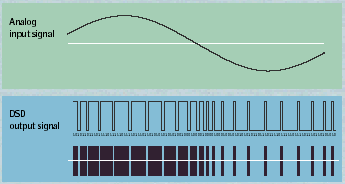
The DSD pulse train "looks" remarkably like the analog waveform it
represents. More pulses point up as the wave goes positive and down
as the wave goes negative.
Multi-channel Super Audio CD
Producers also have the option of creating multi-channel Super Audio CDs
that can transport you to the acoustic space of the original recording. You'll hear
the most convincing soundstage ever presented at home. Super Audio CD multichannel
sound is based on the international standard ITU-R speaker setup. So
it's directly compatible with many of today's home theatre speaker systems.
For full compatibility with pure stereo Super Audio CD players, every multichannel
Super Audio CD includes a complete stereo rendition from the hand of
the producer. You're never at the mercy of a computerized "fold-down" of the
multi-channel mix. You'll always hear the producer's original intent.

Super Audio CD multi-channel sound is based on the international ITUR
standard.
- Hybrid Disc
Furthermore, there is an option to add a separate CD layer to the DVD disc: the so called ‘Hybrid Super Audio CD'. Hybrid SA-CD’s can be played back on virtually all CD drives and players as well as all standard DVD-Video systems. This makes Super Audio CD’s compatible with all the 11 billion CD and DVD players used around the world.


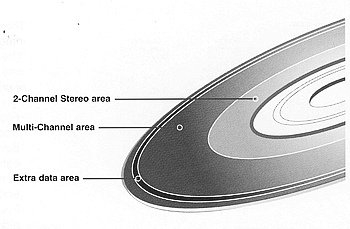
Every multi-channel Super Audio CD includes a separate 2-channel
stereo mix, done by the hand of the producer—not by a computer.
4 types of Discs
There are four different SA-CD configurations commercially available to record companies:
 The vast majority of SA-CD’s introduced on the market today are hybrid type, containing the CD layer. This disc plays on a CD and DVD player, at CD quality.
The vast majority of SA-CD’s introduced on the market today are hybrid type, containing the CD layer. This disc plays on a CD and DVD player, at CD quality.
 There are also SA-CDs without the CD layer, so-called single layer discs. These cannot be played on a standard CD player. The advantage is that this is an entirely secure digital carrier.
There are also SA-CDs without the CD layer, so-called single layer discs. These cannot be played on a standard CD player. The advantage is that this is an entirely secure digital carrier.
Both the hybrid and single layer SA-CD can be released as a stereo-only album, or as a stereo plus surround album.

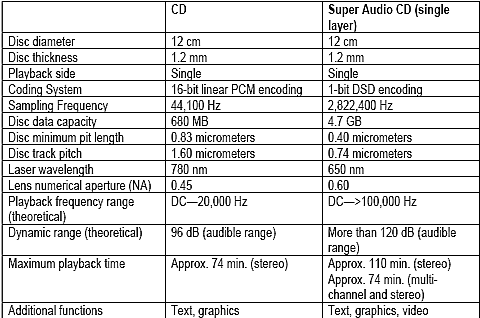
Content Protection
Super Audio CD offers the world’s most secure digital carrier, utilising a combination of physical and electronic protection barriers. These are layered around the audio content in five independent layers, including a combination of mechanical and encryption-based protection systems that cannot be broken using any current hacking technique.
The end result is that when you buy a Super Audio CD in a music store, you can be confident that it’s the genuine article and not an illegal, inferior quality copy.
The CD layer on the hybrid disc is similar to a conventional CD in that it’s open to copying onto other carriers for home use.
3. Unpacking
Sony SCD-XB790 SACD Player - Page 3
Unpacking

The retail package includes the following:
- Audio Stereo connection cable
- Remote commander RM-SX700
- R06 ( size AA) batteries ( x2)
- Multi language manual
- Warranty
- Coupon for a free SACD disc
A coaxial cable for digital sound reproduction would be welcomed.


On the right hand side of the front panel, there are buttons for eject, play, pause, stop, skip (AMS) and fast forward.
On the left there are the power button, headphones jack with volume level adjust. The four remaining buttons include the unit's menu button, read text from the disc, change between SACD and CD and from Multichannel to Stereo 2CH.

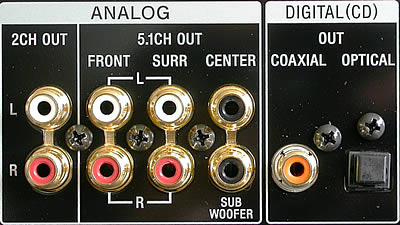
On the rear panel there are the stereo 2CH output as well as the Multichannel 5.1CH outputs, which means that the unit has a built-in 5.1CH decoder. Both coaxial and optical digital outputs are a plus on the unit.
The included RM-SX700 remote control, is easy to use and includes everything for controlling the player, apart from an eject button. Click on the image for an enlarged view.

Below you can see Sony's well known chipset, which is also installed in many other devices, the CXD2753 DSD decoder, responsible for the SACD reproduction:
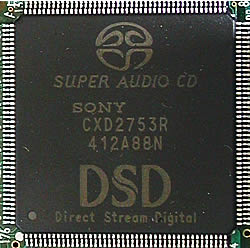
DSD decoder LSI
The Super Audio CD’s 1-bit signal is processed and decoded by Sony's
CXD2753 DSD decoder LSI. This integrated circuit makes intelligent decisions
regarding the incoming data to form the 1-bit audio signal. The LSI first reads the
Watermark—a feature protecting Super Audio Compact Discs from piracy—and
then decodes the incoming data. The LSI uses internal memory to take data
that's output intermittently from the disc, rearrange it and order it into continuous
1-bit audio streams. This LSI also reads sub code data such as the Table of
Contents, track number, track time and text data.
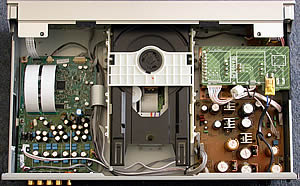
Inside of the SCD-XB790 SACD Player
Click to enlarge
Apart from the external appearance which is more than impressive, when we remove the player's cover, something we don't recommend you to do (for this reason we have supplied the photo above), we saw the immaculate work Sony has done on this model. Solid aluminium, with minimum use of plastic and a very impressive power supply which is not normally found on ordinary players, but more closely matches those found on hi-end, professional equipment.
4. Control Menu
Sony SCD-XB790 SACD Player - Page 4
Control Menu
Some screenshots from the player's menu can be seen below:

CD reproduction

SACD 2CH reproduction

SACD MCH reproduction
 |
 |
| CD-Text |

90min Test Disc

99min Test Disc

Shuffle
 |
 |
| Program function with A-B repeat feature |
- Menu



From "MCH SPK MODE" in the Menu, with SACD enabled, you can select your preference from among 7 settings. These are:
| Playback Mode |
Front Speakers |
Center Speaker |
Surround Speakers |
Sub woofer |
| MCH Direct |
Each signal outputs directly from each speaker |
| 5-Large + SW |
Large |
Large |
Large |
Yes |
| 5-Large |
Large |
Large |
Large |
No |
| 5-Small + SW |
Small |
Small |
Small |
Yes |
| FRT-Large + SW |
Large |
Small |
Small |
Yes |
| FRT-Large |
Large |
Small |
Small |
No |
| No-CNTR + SW |
Large |
No |
Large |
Yes |
| No-CNTR |
Large |
No |
Large |
No |
For example:


When MCH is enabled, a light located at top center turns blue to indicate this condition.

The balance is fully adjustable: (e.g. between the front and rear, the Sub woofer, etc). Some screenshots below:


If the unit is set to "2CH SPK MODE", there are two available settings:
| Playback Mode |
Front Speakers |
Sub woofer |
| 2CH Direct |
Each signal outputs directly from front speakers. No signal outputs from the Sub woofer. |
| 2CH + SW |
Yes |
Yes |
Navigating through the menus is simple. Of course you'll need to spend some time to learn how to use it but the included manual will help you at every step.
5. Reading Tests
Sony SCD-XB790 SACD Player - Page 5
Reading Tests
The Sony SCD-XB790 supports SACD/CD playback.
The *.cda files on any audioCD are recognized flawlessly, regardless of whether the disc
is factory pressed or a CD-R/RW while CD-Text is also supported.
 In
addition, no problems were noticed when we played 8cm CD-R/-RW (185MB) or 99min
CD-R discs. In the case of our 90min test CD, the SCD-XB790 managed to play 18 out of 20 tracks. On the last two tracks, there was some freezing during playback.
In
addition, no problems were noticed when we played 8cm CD-R/-RW (185MB) or 99min
CD-R discs. In the case of our 90min test CD, the SCD-XB790 managed to play 18 out of 20 tracks. On the last two tracks, there was some freezing during playback.
For anyone that has purchased any protected audio discs from
their music store, the Sony SCD-XB790 will not let you down. We tested
"Natalie
Impruglia - White Lilies island" disc, protected with Macrovision's Key2Audio
protection system, and "Celine Dion - A New Day Has Come", protected
with Cactus Data Shield 200. Both titles were recognized and played flawlessly.
In truth, these protection schemes
are designed to discourage PC users from copying them and as such
present problems with drives designed for PCs only.
-
Compressed Audio (data CD)
 Although the specifications for this player don't mention MP3 playback, we decided to test it anyway. None of the following compressed audio formats could be played with the player.
Although the specifications for this player don't mention MP3 playback, we decided to test it anyway. None of the following compressed audio formats could be played with the player.
Compression type |
Compression settings |
Recognize / Play |
MP3 |
CBR 20kBit 11025Hz Mono |
No
|
CBR 20kBit 11025Hz Stereo |
CBR 32kBit 11025Hz Stereo |
CBR 32kBit 22050Hz Mono |
CBR 40kBit 22050Hz Stereo |
CBR 48kBit 22050Hz Stereo |
CBR 48kBit 44100Hz Mono |
CBR 56kBit 22050Hz Mono |
CBR 56kBit 44100Hz Mono |
CBR 64kBit 22050Hz Stereo |
CBR 96kBit 22050Hz Stereo |
CBR 96kBit 44100Hz Mono |
CBR 96kBit 44100Hz Stereo |
CBR 112kBit 44100Hz Stereo |
CBR 128kBit 44100Hz Mono |
CBR 128kBit 44100Hz Stereo |
CBR 160kBit 44100Hz Stereo |
CBR 192kBit 44100Hz Stereo |
CBR 224kBit 44100Hz Stereo |
CBR 256kBit 44100Hz Stereo |
CBR 320kBit 44100Hz Stereo |
VBR - High compression |
VBR - Highest compression |
VBR - Low compression |
VBR - Lowest compression |
VBR - Medium compression |
Windows Media Audio
(WMA)
|
WMA 48kbps |
WMA 64kbps |
WMA 96kbps |
WMA 128kbps |
WMA 160kbps |
WMA 192kbps |
WAV |
WAV |
The Sony SCD-XB790 supports Super AudioCDs, which is its main feature and the reason for its existence.
You don't need to be an expert to notice the difference during playback between
a normal CD and a SACD. We played several SACDs, some of which could be played on both SACD and CD devices with both multichannel and 2CH support. Simply by listening with the bare ear, we were able to confirm the tremendous difference in sound reproduction. With SACD, the sound is more detailed with excellent bass and volume. Sony SCD-XB790 has done a very good job in this department.
6. Error Correction Tests
Sony SCD-XB790 SACD Player - Page 6
Error Correction
Tests
This
is an AudioCD disc used for measuring the error correction
capabilities and adjustment of the tracking/focusing servo characteristics of a player
against defects included on a typical CD. Three kinds of defects are included
on this disc: interruption in information layer, black dots and fingerprints.
The interruptions are fabricated by intentionally varying the lengths of pits
on the disc fabrication area. Their size varies from 0.5mm to 1.0mm. The diameter
of the black dots are sized from 0.4mm to 1.0mm. Lastly, the simulated fingerprints
are small gathered dots, of diameters sized from 65 micrometers to
75 micrometers 160 black dots in total, construct the artificial fingerprint.
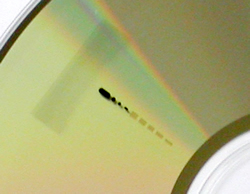
The interruptions on the information layer were not a problem, as was also the case with 65 to
75 micrometer fingerprints. Black dots larger than 1.0mm in size, produced a couple of audible clicks. This is supposed to be an easy test disc and we expected better performance.
The
test concept with the Philips SBC 44A is the same as in the previous test disc.
Interruptions on the information layer vary from 400 micrometers to 1000
micrometers, while the black dots have a size of 300 micrometers to 800 micrometers
No audible clicks or skipping occurred during playback indicating very good performance.

Same contents as with the Abex TCD-726 but different defects. A scratch sized
from 0.4mm to 3.0mm on the disc's surface. Error symptoms expected when
playing this disc are noise, skipping, same sector repeatedly played, start
of tune cannot be detected etc. This test disc is more difficult than the Abex TCD-726.
The performance of the Sony player was poor. The first five tracks, with scratches up to 1.0mm, were played without problems while the remaining ten track were a problem. Scratches over 2.0mm forced the player to freeze.
We finish this test cycle with the CD-Check disc from Digital Recordings.
Five audio signals (5 tracks) in combination with disc error patterns are used to rate
the player's ability to read music and reproduce it completely. The five tracks
contain a sequence of progressively more difficult tests.
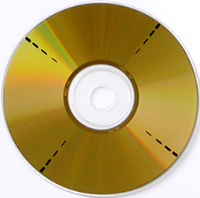
Check level 1 (track 1): Standard manufacturing errors
Check level 2 (track 2): 0.375mm scratch
Check level 3 (track 3): 0.750mm scratch
Check level 4 (track 2): 1.125mm scratch
Check level 5 (track 2): 1.500mm scratch
Any clicks, interruptions
or looping during audio reproduction indicate failure of a Check level (audio
track). Below you can see the test results:
Check level |
1 |
2 |
3 |
4 |
5 |
Result |
OK |
OK |
OK |
Audible clicks |
Audible clicks |
The truth is that since this review is about a CD player, we expected much better error correction capabilities. Discs, in not the best condition, should probably be avoided with this player.
7. Conclusion
Sony SCD-XB790 SACD Player
- Page 7
Conclusion

We will begin our conclusion for the Sony SCD-XB790 SACD Player, with the price tag for this player on the market. Close to €350, which is a very reasonable price for this device. Especially if we consider the construction, power supply, chassis etc, the player reminds us of more expensive, hi-end equipment. However, this amount could also be spent on a universal device, that also supports SACD reproduction along with a whole array of other formats which would be more easily appreciated by most enthusiasts.
The CD error correction capabilities, we have to admit, were disappointing and we expected much better performance from such a device, especially when we consider that SACD/CD are the only supported formats. Defects and scratches up to 1.0mm and over, created audible clicks. However, since this is not a common player, I am sure that most candidate buyers would be the type who take care of their discs :-).
According to our reading tests, the player confirmed the manufacturer's specifications. It also proved to be very simple in operation. However, one feature missing, always keeping in mind that this is a CD player, is MP3 support. We listened to this player in both multi-channel and stereo mode, playing a variety of material including CD, SACD, CD-R and CD-RW discs. In my opinion and with my limited experience, I can say that the player offers better than good, if not not very good sound quality.
| Design & Body |
 |
| Reading |
 |
| Media Compatibility |
 |
| Ease of use |
 |
| Features |
 |
| Connectivity |
 |
| Value for money |
 |